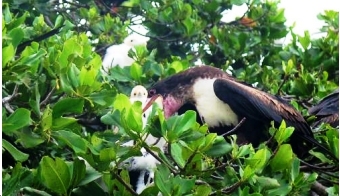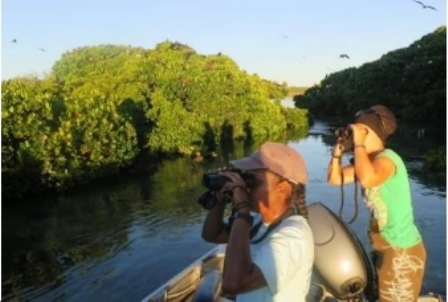Aldabra 2018 frigatebird census completed |04 June 2018

In February the Aldabra research team conducted this year’s frigatebird census. In this annual monitoring event all four breeding colonies were surveyed and all nests of both the lesser and the greater frigatebird were counted.
During the census the number of nests is equated with the number of breeding pairs.
If adults are present on the nest they are counted per species.
However, often parents go away to find food leaving their chick alone on the nest; since chicks of the two species are largely indistinguishable without careful inspection they are counted as one group.
This year nest numbers were high: a total of 7713 nests were counted compared to 4453 in 2017.
This difference in counts is not unusual; due to the very long breeding cycle of frigatebirds the proportion of the population that is able to attempt breeding fluctuates between years.
The 2018 nest total is similar to that recorded in 2011, 2013 and 2015 showing that the combined frigatebird breeding population has not declined over this time period.

Of the total nest count, unguarded chicks and adult lesser frigatebirds on nests each numbered around 3800 while only 140 greater frigatebirds were counted. The actual number of breeding greater frigatebirds this season is certainly much higher.
Our ongoing monitoring of breeding cycles for the two species showed us that the peak nesting time of greater frigatebirds was in October.
By February, many of their chicks had fledged or were old enough to be left unaccompanied so the number of adults left sitting on nests was much reduced compared to numbers at peak nesting time.
In contrast lesser frigatebirds did not reach their nesting peak until February at the time of the census.
Seeing such stark differences in breeding chronology between species highlights the importance of timing in census counts and the difficulties in estimating the breeding population size of each species.
We expect that the continuation of breeding cycle monitoring over a two-year period will help us to understand the population dynamics of the breeding colonies even further.
SIF




